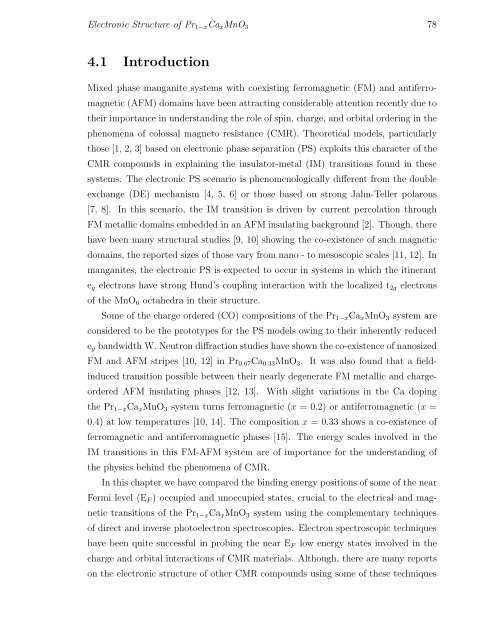PHYS07200604007 Manas Kumar Dala - Homi Bhabha National ...
PHYS07200604007 Manas Kumar Dala - Homi Bhabha National ...
PHYS07200604007 Manas Kumar Dala - Homi Bhabha National ...
Create successful ePaper yourself
Turn your PDF publications into a flip-book with our unique Google optimized e-Paper software.
Electronic Structure of Pr 1−x Ca x MnO 3 78<br />
4.1 Introduction<br />
Mixed phase manganite systems with coexisting ferromagnetic (FM) and antiferromagnetic<br />
(AFM) domains have been attracting considerable attention recently due to<br />
their importance in understanding the role of spin, charge, and orbital ordering in the<br />
phenomena of colossal magneto resistance (CMR). Theoretical models, particularly<br />
those [1, 2, 3] based on electronic phase separation (PS) exploits this character of the<br />
CMR compounds in explaining the insulator-metal (IM) transitions found in these<br />
systems. The electronic PS scenario is phenomenologically different from the double<br />
exchange (DE) mechanism [4, 5, 6] or those based on strong Jahn-Teller polarons<br />
[7, 8]. In this scenario, the IM transition is driven by current percolation through<br />
FM metallic domains embedded in an AFM insulating background [2]. Though, there<br />
have been many structural studies [9, 10] showing the co-existence of such magnetic<br />
domains, the reported sizes of those vary from nano - to mesoscopic scales [11, 12]. In<br />
manganites, the electronic PS is expected to occur in systems in which the itinerant<br />
e g electrons have strong Hund’s coupling interaction with the localized t 2g electrons<br />
of the MnO 6 octahedra in their structure.<br />
Some of the charge ordered (CO) compositions of the Pr 1−x Ca x MnO 3 system are<br />
considered to be the prototypes for the PS models owing to their inherently reduced<br />
e g bandwidth W. Neutron diffraction studies have shown the co-existence of nanosized<br />
FM and AFM stripes [10, 12] in Pr 0.67 Ca 0.33 MnO 3 . It was also found that a fieldinduced<br />
transition possible between their nearly degenerate FM metallic and chargeordered<br />
AFM insulating phases [12, 13]. With slight variations in the Ca doping<br />
the Pr 1−x Ca x MnO 3 system turns ferromagnetic (x = 0.2) or antiferromagnetic (x =<br />
0.4) at low temperatures [10, 14]. The composition x = 0.33 shows a co-existence of<br />
ferromagnetic and antiferromagnetic phases [15]. The energy scales involved in the<br />
IM transitions in this FM-AFM system are of importance for the understanding of<br />
the physics behind the phenomena of CMR.<br />
In this chapter we have compared the binding energy positions of some of the near<br />
Fermi level (E F ) occupied and unoccupied states, crucial to the electrical and magnetic<br />
transitions of the Pr 1−x Ca x MnO 3 system using the complementary techniques<br />
of direct and inverse photoelectron spectroscopies. Electron spectroscopic techniques<br />
have been quite successful in probing the near E F low energy states involved in the<br />
charge and orbital interactions of CMR materials. Although, there are many reports<br />
on the electronic structure of other CMR compounds using some of these techniques
















